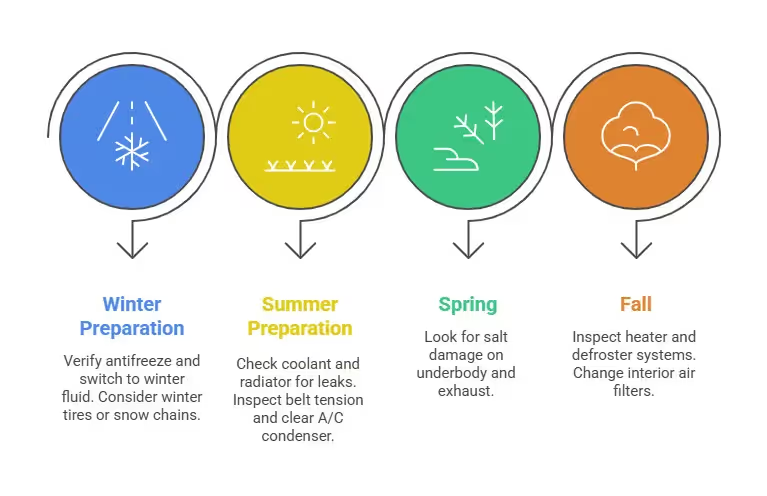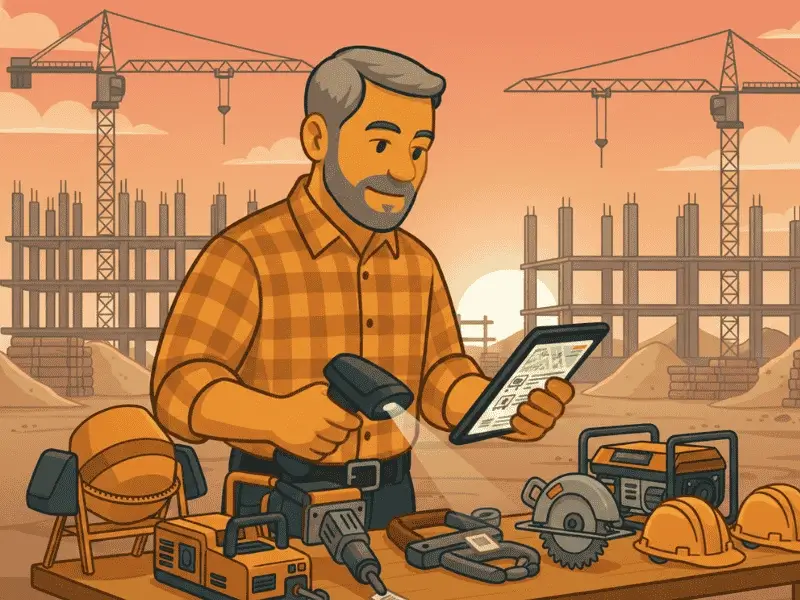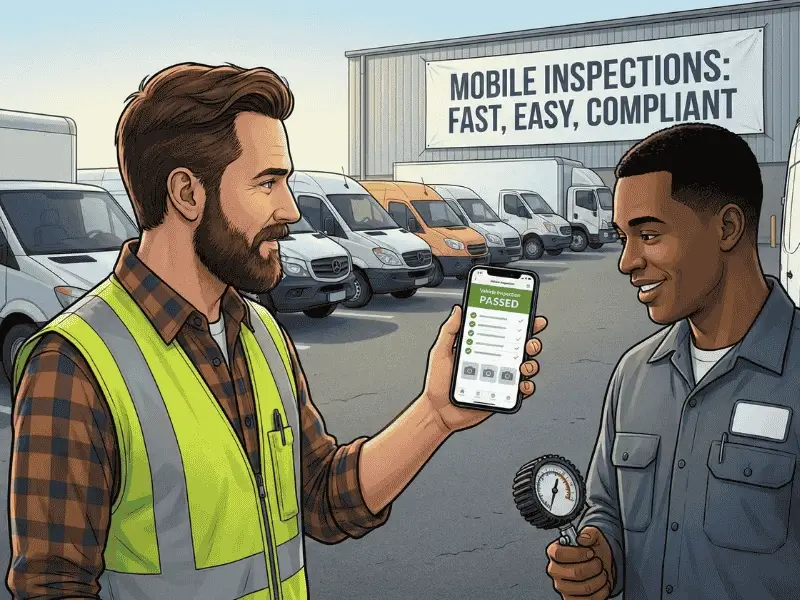Key Takeaways
- Catch safety hazards before they cause accidents. A thorough inspection identifies worn brakes, bald tires, and leak risks.
- Daily walk-arounds vs. monthly deep dives. Quick pre-trip checks (brakes, lights, tires) take 5–15 minutes; full inspections take 30–60 minutes.
- Digital inspection apps eliminate manual errors. In 2024, 68% of fleets went digital—cutting inspection mistakes by 35%. (Source: 2024 NHTSA Fleet Tech Report)
- Skipping inspections costs more than you think. From fines and registration delays to engine rebuilds, neglecting checks can cost thousands.
Vehicle safety and maintenance often take a backseat, posing significant risks to drivers, passengers, and pedestrians alike. Despite the critical importance of regular vehicle inspections in identifying potential hazards and ensuring vehicles meet safety standards, many overlook this essential practice. The lack of awareness and understanding about what goes into a vehicle inspection contributes to this negligence. This not only endangers lives but also leads to costly repairs down the line.
Addressing this issue head-on, the solution lies in educating vehicle owners about the importance of vehicle inspections through clear, accessible information. In this article, we will discuss what inspections entail the benefits they offer, and a simple fleet vehicle inspection checklist for your fleet.
What Things Are Checked During a Vehicle Inspection?
1. Brake System (Brake Test)
Why It Matters: Properly functioning brakes are critical for accident prevention—worn pads or leaking lines can lead to total brake failure.
How to Check: Press firmly on the brake pedal—if it feels soft or spongy, suspect air in lines or worn pads. Visually inspect pads through the wheel; look for less than 1/4" thickness.
If left unchecked, worn brake pads can lead to total brake failure—and cost your fleet hundreds in emergency repairs.
How to Inspect Brake Fluid for Contamination
Open the reservoir and dip a clean cotton swab into the fluid. It should look translucent amber. Dark or cloudy fluid indicates moisture contamination and requires a full brake fluid flush.
2. Tires
Why It Matters: Tires are your only contact point with the road—underinflation or worn tread increases accident risk and hurts fuel economy.
How to Check: Use a reliable tread depth gauge—anything under 4/32" means it’s time for replacement. Check inflation with a tire pressure gauge and compare to manufacturer specs.
Ignoring low tire pressure can cause blowouts, reduced fuel efficiency, and uneven wear—costing you $200 in downtime and replacements.
How to Measure Tread Depth
Insert a tread depth gauge into the deepest groove. Readings below 4/32" signal the need for immediate replacement. Also scan for uneven wear patterns, which could indicate alignment issues.
3. Lights & Signals
Why It Matters: Malfunctioning turn signals or brake lights can lead to confusion on the road—accident risk increases by up to 30% when other drivers can’t predict your moves.
How to Check: Turn on headlights, blinkers, and brake lights. Walk around the vehicle to confirm each lamp illuminates brightly and evenly.
Failing to notice a burned-out brake light can result in tickets or rear-end collisions—repairing damage often costs more than $500.
Detecting a Faulty Turn Signal Relay
If a turn signal clicks unevenly (too rapid or silent), remove and swap the relay with a known good one. No click means it’s time to replace the relay.
4. Steering & Suspension
Why It Matters: Worn tie rods, ball joints, or shocks compromise handling and can cause uneven tire wear. In extreme cases, steering components can fail, leading to loss of control.
How to Check: Jack up the front end (or have a lift). Grab each wheel at 3 & 9 o’clock and wiggle—excessive play indicates worn ball joints or tie rods. Inspect shocks for leaking fluid or broken mounts.
Neglecting suspension checks often results in poor vehicle control and uneven tire wear, adding hundreds in premature tire replacements.
5. Emissions & Exhaust
Why It Matters: Most regions mandate emissions compliance—failing these tests can lead to hefty fines or registration blocks. Leaking exhaust can also let dangerous carbon monoxide into the cabin.
How to Check: Use a roadside emissions analyzer (if equipped) or visually inspect the exhaust system for holes, rust, or loose clamps. Look underneath for black soot trails, which indicate rich running conditions.
Failing an emissions test can cost $150–$300 in fines and force unscheduled repairs to catalytic converters or sensors.
6. Fluid Levels & Belts
Why It Matters: Low or contaminated fluids (engine oil, coolant, brake fluid) degrade component life and risk overheating or brake failure. Worn belts can snap, leaving you stranded.
How to Check: With the engine cold, check oil via dipstick—look for proper level and clarity (amber color). Inspect coolant reservoir for correct fill line, and feel belt tension—no more than ½" of play in the middle.
Skipping fluid checks often leads to overheating or seized engines—repair or rebuild costs can exceed $1,200.
7. Battery & Electrical System
Why It Matters: A weak or corroded battery can leave you sidelined—especially in extreme temperatures. Alternator or starter issues often start with poor connections or low voltage.
How to Check: Measure battery voltage with a multimeter—it should read around 12.6V at rest. Inspect terminals for corrosion (white/green powder). Test alternator output at ~13.8–14.2V with engine running.
Overlooking battery health can cause no-starts in critical moments—towing and jump-start fees can exceed $100 per incident.
8. Windshield & Wipers
Why It Matters: Cracked or chipped windshields reduce visibility and can shatter under stress. Faulty wipers hamper visibility in rain or snow.
How to Check: Look for cracks or chips larger than a quarter—repair or replace immediately. Turn on wipers and spray washer fluid; ensure blades clear the entire windshield without streaking.
Driving with a compromised windshield increases accident risk—and a full replacement can cost $200–$400.
9. Exhaust System
Why It Matters: Leaks in the exhaust can saturate the cab with carbon monoxide—a silent killer. Rusted or damaged pipes also reduce engine performance and increase fuel consumption.
How to Check: With the engine running, listen for hisses or popping sounds under the vehicle. Inspect pipes and muffler for rust holes or loose hangers.
Ignoring exhaust leaks can lead to cabin poisoning and higher fuel bills—repair costs often exceed $300 once rust has eaten through.
Special Considerations for EV & Hybrid Fleets
Electric and hybrid vehicles have unique inspection needs:
- Battery Health: Use onboard diagnostics or a dedicated tester to check state-of-charge and health. Look for swelling or leaks in battery packs.
- High-Voltage System Warnings: Verify dashboard warning lights remain off. Any HV fault code requires immediate service by qualified EV technicians.
- Brake Regeneration Systems: Regenerative braking can mask traditional friction pad wear. Even if your pads look thick, check for uneven wear patterns caused by mixed regen and friction braking.
EV batteries overheat if coolant isn’t topped off—overheating can degrade battery life by 20% over time.
Download Your Free Vehicle Inspection Checklist
Seasonal Inspection Tips

The Seasonal Car Inspection Tips diagram shown above, shows...
- Winter Preparation:
- Verify antifreeze concentrations (50/50 mix), inspect heater core hoses, and switch to winter-rated windshield fluid.
- Consider swapping to winter-rated tires or checking snow chain compatibility for areas with heavy snowfall.
- Summer Preparation:
- Check coolant and radiator condition—look for leaks around hoses and clamps.
- Inspect belt tension thoroughly; heat can accelerate belt cracking. Ensure A/C condenser fins are clear of debris.
- Spring/Fall:
- Spring: Look for salt damage on underbody and exhaust, especially if winter roads used de-icing chemicals.
- Fall: Inspect heater and defroster systems; ensure interior air filters are changed before pollen buildup.
Paper Checklist vs. Digital Inspection Apps
- Paper Checklist:
- Pros: Low cost, no training needed.
- Cons: Manual errors, no photo/video proof, lost records.
- Digital Inspection Apps (DVIRs):
- Automatic Record-Keeping: All checks are time-stamped and stored in the cloud.
- Real-Time Photo/Video Capture: Snap images of issues instantly—no more “he said/she said.”
- Easier Customer Communication: Instantly share reports or work orders with clients via email or SMS.
In 2024, 68% of fleets adopted digital DVIRs, cutting manual errors by 35%. (Source: 2024 NHTSA Fleet Tech Report)
How Often Should You Inspect Your Fleet?
Most fleets perform a daily pre-trip walk-around, primarily checking brakes, lights, and tire inflation. A full, detailed inspection is recommended every 30 days or every 10,000 miles, whichever comes first.
- Why These Intervals Matter:
- Wear Rates: Brake pads and tires wear at roughly linear rates; 10,000 miles is commonly when pads drop below 25% thickness.
- Warranty Schedules: Many OEMs warranty parts coverage around 10,000 mile service intervals.
- Compliance Cycles: Annual or semi-annual regulatory inspections usually coincide with calendar or mileage thresholds.
In-House vs. Outsourced Inspections: Pros & Cons
- In-House Inspections ($100–$150/vehicle/month):
- Pro: Immediate feedback loop—drivers and mechanics fix issues on the spot.
- Con: Requires trained staff, equipment overhead, and scheduling coordination.
- Outsourced Inspections ($200–$250/inspection):
- Pro: Certified inspectors handle complex checks (e.g., DOT or state-mandated), relieving internal teams.
- Con: Longer lead times for appointments and potential travel charges.
Vehicle Inspection Report (Including DOT Inspection Details)
A formal inspection report serves as legal proof of roadworthiness. For commercial fleets subject to DOT regulations, a DOT pre-trip inspection must include:
- Brake system: pads, hoses, and fluid levels
- Steering and suspension: tie rods, ball joints, leaf springs
- Tires and wheels: tread depth (minimum 2/32"), proper inflation, wheel lug torque
- Lights and reflectors: headlights, brake lights, side markers, license plate illumination
- Emergency equipment: spare tire, jack, triangles or flares
- Fluid levels: engine oil, transmission fluid, coolant, brake fluid
In California, a fleet must meet CARB’s R-series emissions standard. In Texas, the annual safety inspection flags issues like brake linings below safe thickness. Always consult local regulators for exact requirements.
Daily vs. Periodic Inspection
- Daily Walk-Around Checks (5–15 minutes):
- Brakes: Squeeze brake pedals to feel for sponginess.
- Tires: Check pressure and visually inspect for bulges or cuts.
- Lights & Signals: Test headlights, brake lights, and turn signals.
- Periodic Comprehensive Inspections (30–60 minutes every 30 days or 10,000 miles):
- Steering & Suspension: Inspect tie rods, ball joints, and shocks.
- Fluids & Belts: Check oil, coolant, brake fluid, and belt tension.
- Emissions & Exhaust: Verify emissions compliance and look for leaks.
- Battery & Electrical: Test voltage and check terminal corrosion.
- Underbody & Frame: Scan for rust or damage that could compromise safety.
In spring 2024, one school district discovered that 40% of its bus batteries were nearing failure. A scheduled battery check—rather than waiting for a no-start—saved them from last-minute route cancellations.
Top 3 Most Overlooked Inspection Items
- Windshield Wiper Effectiveness: Many fleets check wiper blades visually but skip activating them—streaking or squeaking means they need replacement.
- Valve Stem & Cap Condition: Missing caps or cracked stems can cause slow leaks that don’t show up in a quick pressure check.
- Emergency Equipment Expiration: Fire extinguishers and first-aid kits often have outdated expiration dates but remain tucked away until it’s too late.
2024 Simply Fleet Inspection Data
(Proprietary, anonymized insights from 250 fleets using Simply Fleet)
- 22% reduction in roadside breakdowns when digital walk-around checks were used.
- 43% of vehicles had at least one critical issue missed on paper checklists—digital DVIRs flagged these before they turned into major repairs.
Cost of Failing an Inspection
Related Posts
- The Ultimate Guide to Vehicle Inspection Forms and Inspection App
- Digital Vehicle Inspection Software for eDVIR : A Must-Have Tool for all Fleets
- 20 Things to Check While Performing a Vehicle Inspection in 2025
Final Words
Vehicle inspections play a pivotal role in ensuring the safety, reliability, and compliance of vehicles on the road. The introduction of the Digital Vehicle Inspection System has further transformed the inspection process, offering a more transparent, efficient, and engaging experience for vehicle owners.
The automotive industry can promote a culture of proactive vehicle maintenance, improve customer communications, and ultimately, contribute to safer roads for everyone by adopting these advancements. Vehicle inspections, therefore, are not just a regulatory requirement but a cornerstone of responsible vehicle ownership and public safety.
Vehicle Maintenance Resources:
How to Replace Transmission Fluid
How to Replace Engine Air Filters
How To Replace Your Windshield Wipers



.png)








.png)


.png)



.webp)



